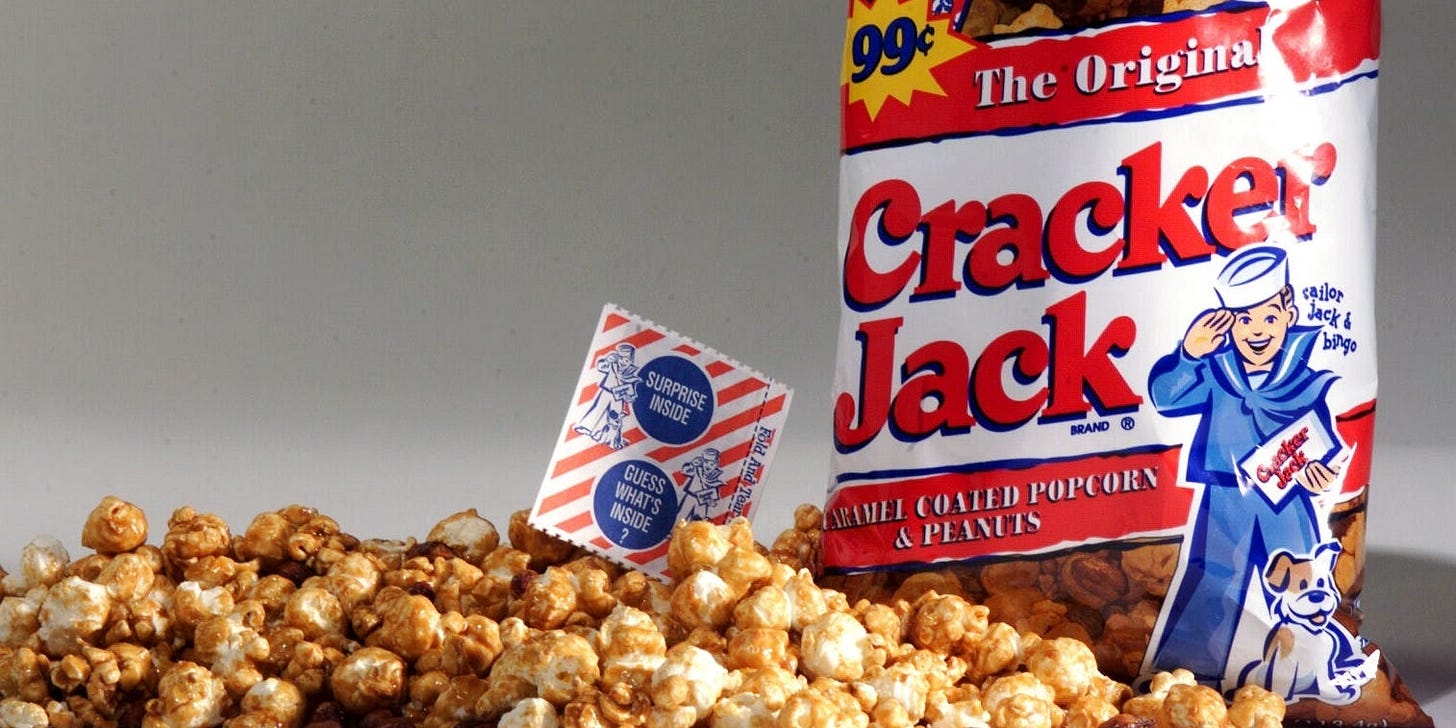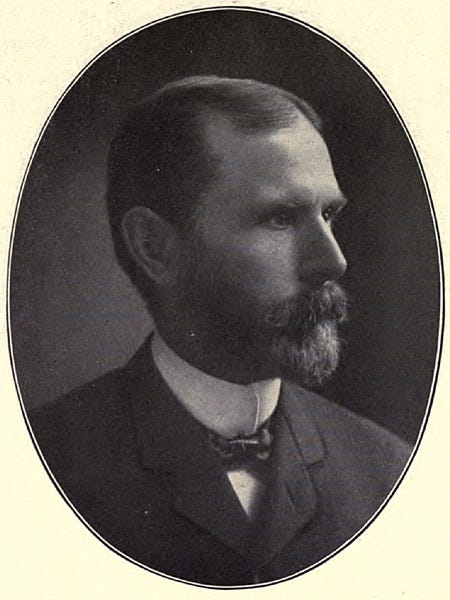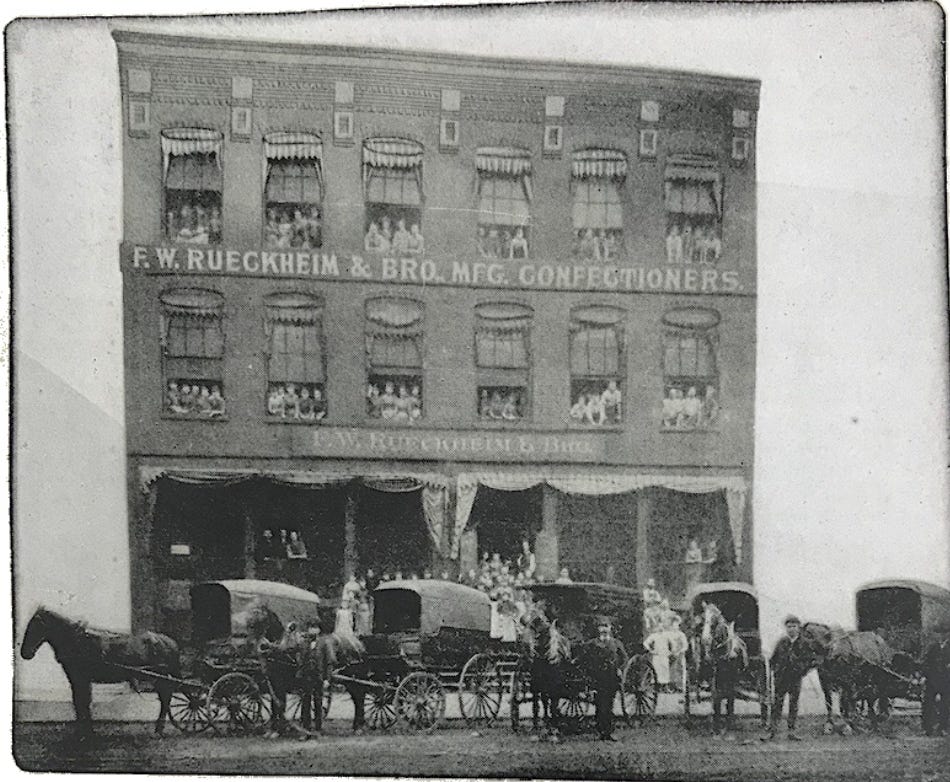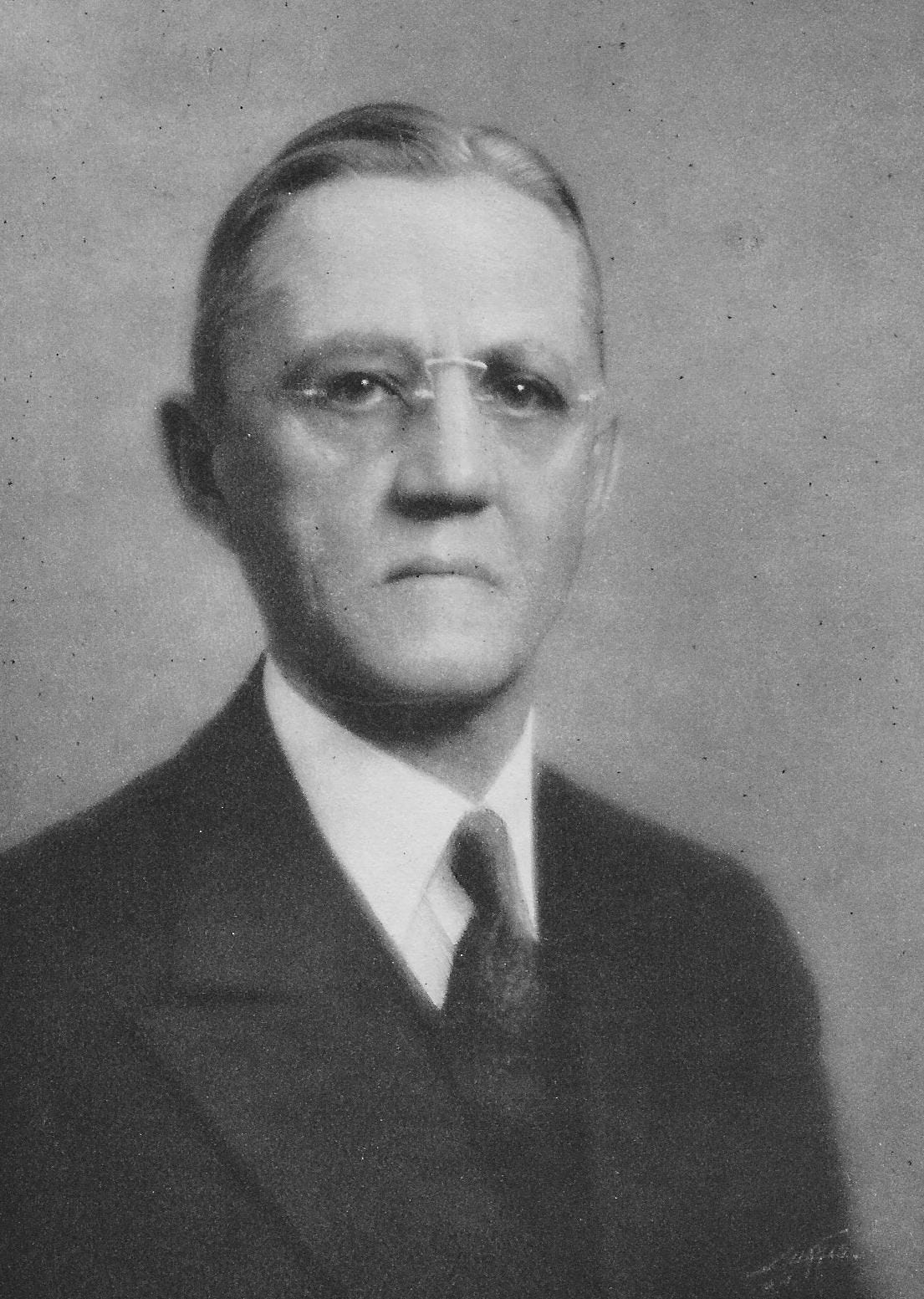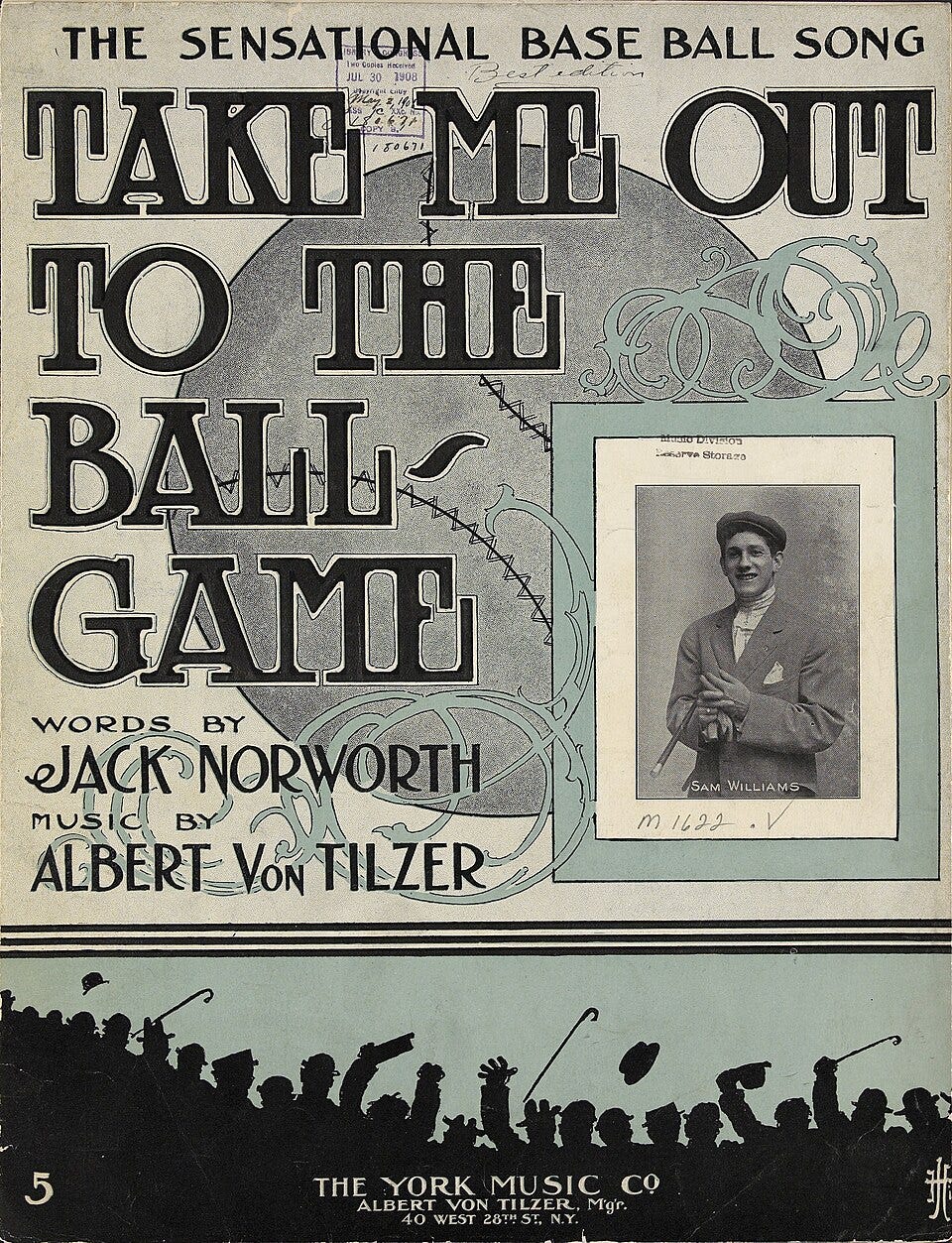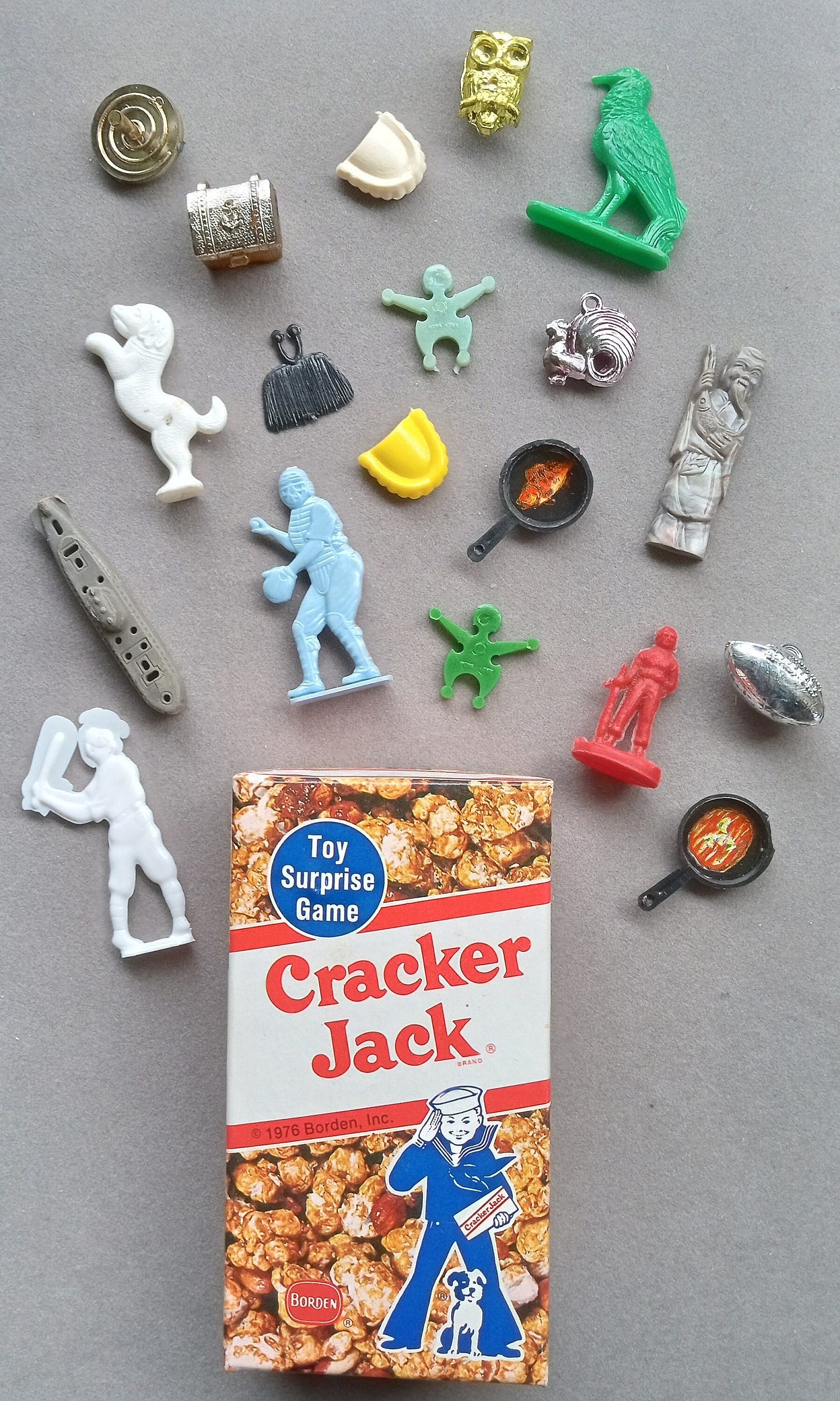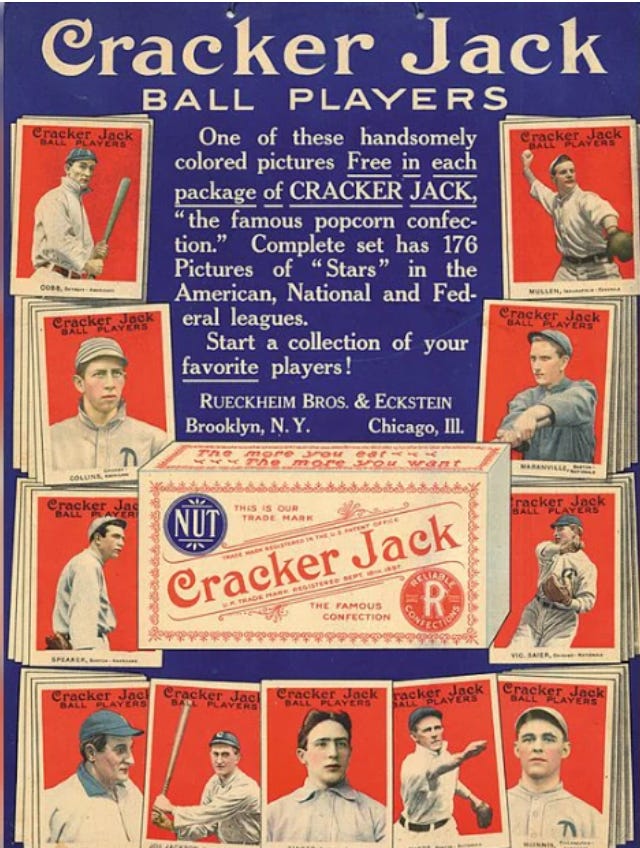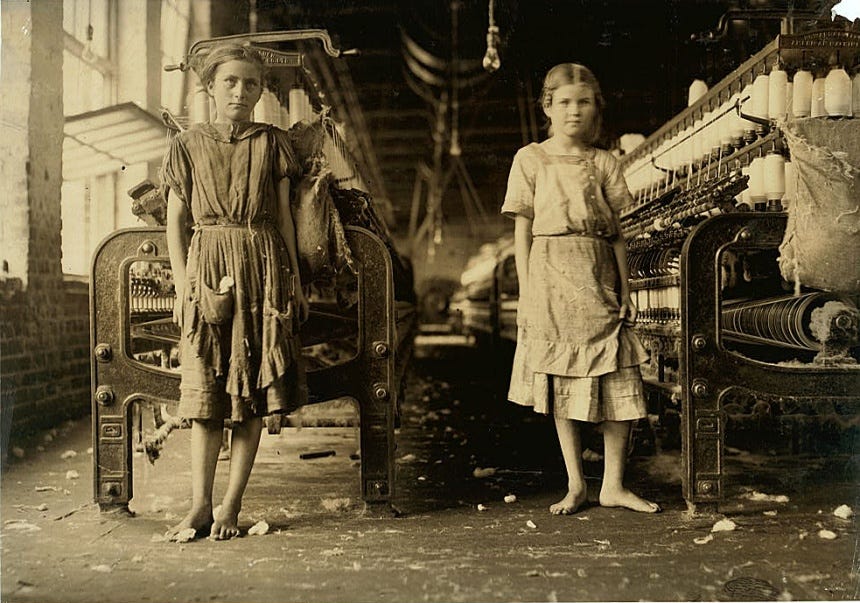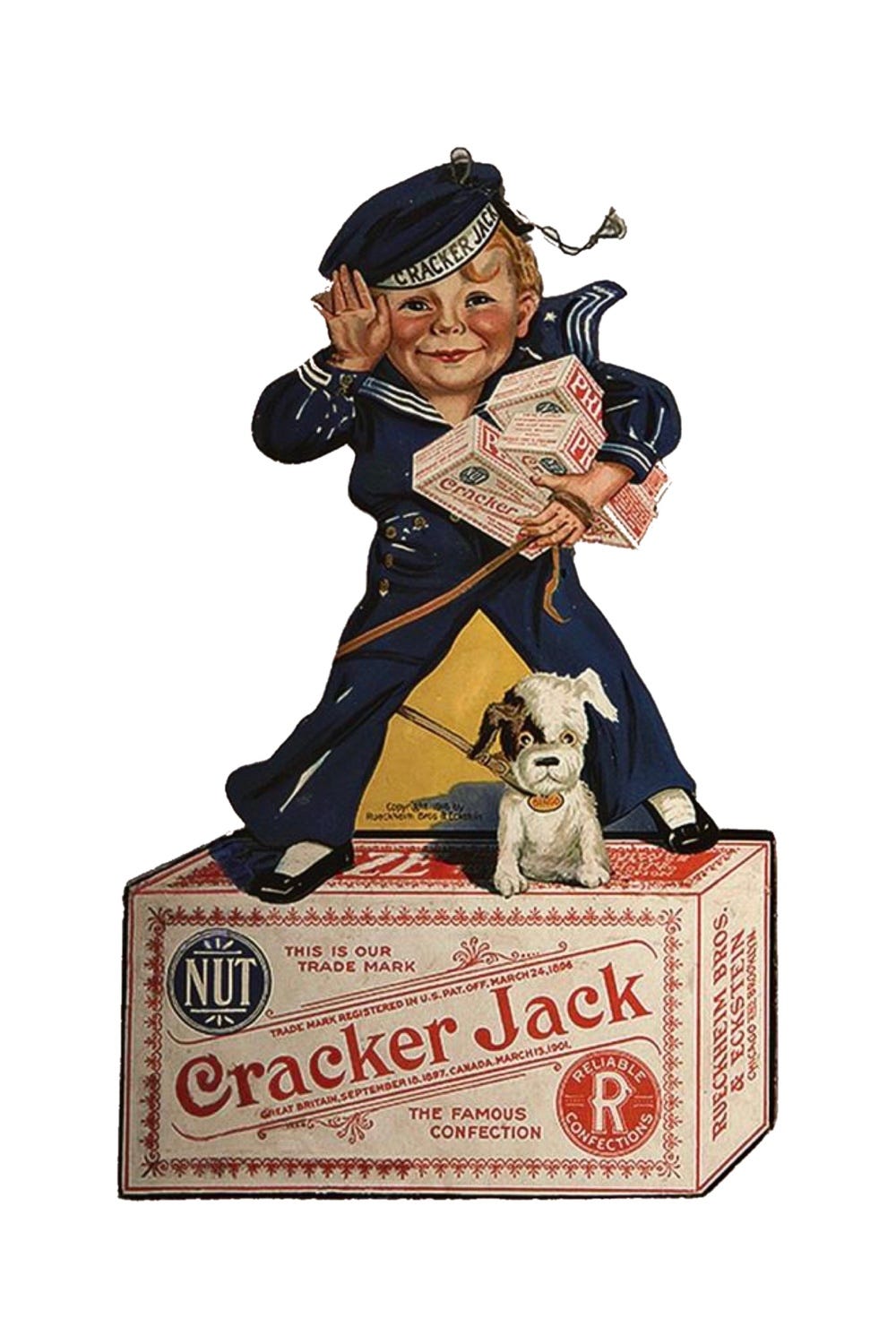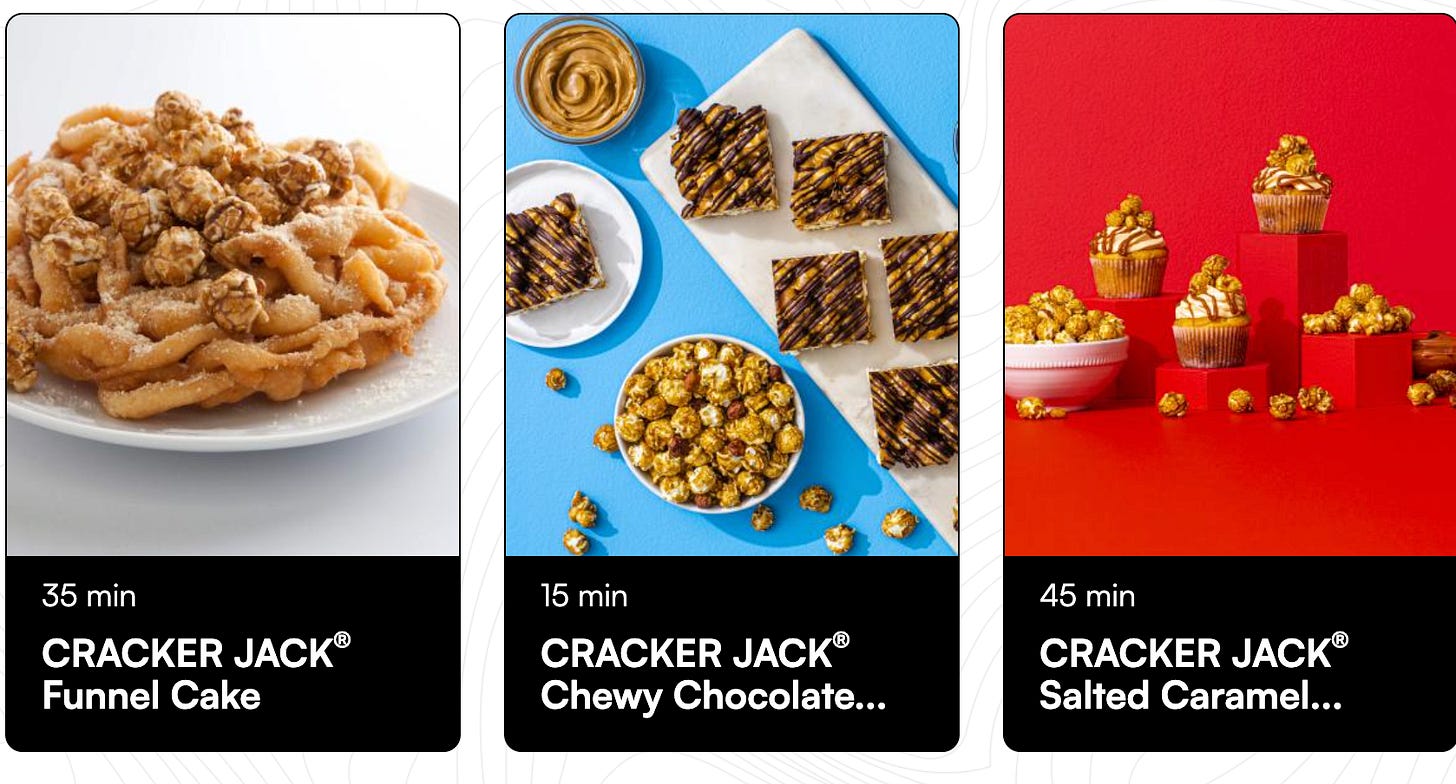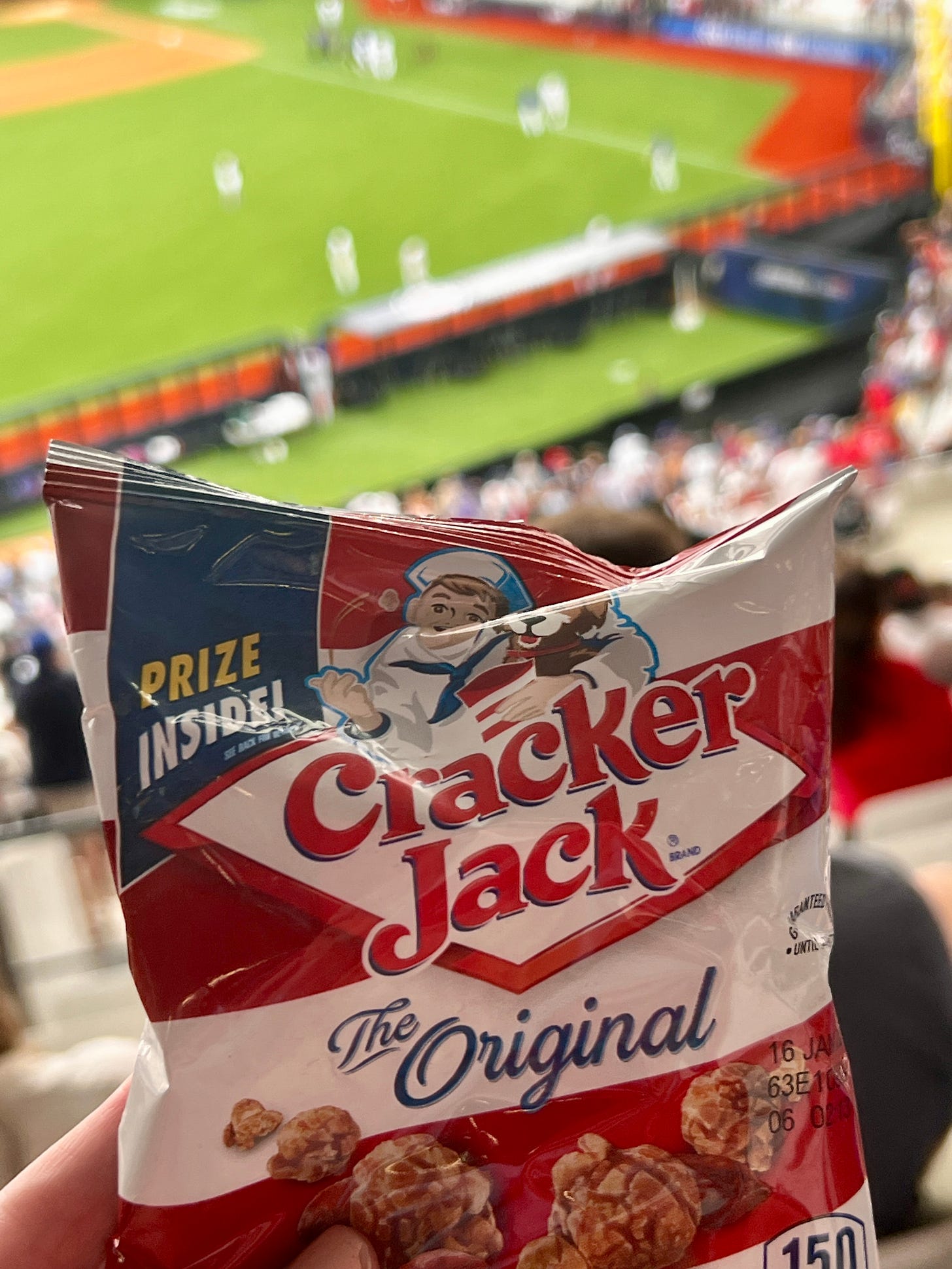Hello!
So as some Curious Minds readers may recall (especially if you read the last issue), I have a thing about baseball in the summer months.
Just an interest — nostalgia, really.
It’s probably intensified because I am living in a part of the world (London) where no one cares about baseball.1
And baseball got me thinking about Cracker Jack, that sweet caramel-coated popcorn and peanuts treat that I associate with the ballpark.
When Major League Baseball brought the Cardinals and Cubs to London two years ago, Cracker Jack was on sale at the concession stands.
I think I paid about $10-12 for a small bag just to share it with my son.

But where did Cracker Jack come from?
I was curious…
Cracker Jack – that most American snack – was actually created by a German immigrant in the late 1800s.
Though I found articles stating definitively what went down, further investigation revealed that there is a lot of folklore about Cracker Jack (some likely created or perpetuated by the company that later purchased it).
I even found some articles debating who the real inventor of Cracker Jack was.
It’s certainly possible that more than one person had the idea of making popcorn sweet – but for today’s story, I’ll share what I learned about the Cracker Jack that we associate with this image:
And it started with this man…
His name was Frederick (Fred) William Rueckheim, and he was born in Germany in 1846.
After serving on the Prussian side of the Austro-Prussian War, he immigrated to America in 1869.
Fred’s uncle had a farm outside Chicago, and offered him a job.
But after the Great Fire of Chicago destroyed much of the city in 1871, Fred saw an opportunity to leave the farm — and he went to the city to help with the cleanup effort.
There he met William Brinkmeyer, who had owned a fairly successful popcorn stand.
With the $200 Fred had saved working for his uncle, he decided to help re-establish Brinkmeyer’s popcorn business.
Apparently, demand for popcorn was popping — and two years later, Fred brought his younger brother Louis into the business, replacing William.2
The two brothers established F.W. Rueckheim & Bro., and sold popcorn out of a tiny office in Chicago.
They later expanded their business when they bought candy-making equipment from a Dutch confectioner who was returning to Holland.
Louis focused on sweet treats and developed their “Reliable Confections” brand.
In 1885, the brothers’ building burned down — and they lost all their equipment and materials.
But, focusing on efficiency and frugality, they carried on.
In 1893, Chicago held their first World’s Fair — and Cracker Jack lore will tell you that this is where their molasses-covered popcorn debuted.
But, did it actually?
Borden, who bought Cracker Jack many years later, tells this story — but the historians at the Made in Chicago Museum suggest otherwise.
“The Rueckheims’ own 50-year company history makes no mention of the World’s Fair at all, and the MANY books from the fair itself are similarly lacking in such tales,” they wrote.
The museum also notes that a March 8, 1896 issue of the Chicago Tribune says the confection is a “very recent invention” that was “scrounged up by Louis Rueckheim as a happy accident.”
“Do not taste it,” the headline read. “If you do, you will part with money easy.”
After first tasting their sweet popcorn creation, Rueckheim is reported to have said, “Das ist ausgezeichnet!”, German for, “That is excellent!”
Another word for ‘excellent’ that was used in America back then was, “crackerjack.”
Later versions of this story conveniently claim a co-worker3 exclaimed, “That’s crackerjack!” after tasting the new product — so who knows what really happened?4
(The German response seems more likely to me.)
The brothers jumped on the slang of the day, calling (and copyrighting) their new molasses-covered popcorn and roasted peanuts creation as “Cracker Jack.”5
And according to the 1896 Tribune article, Cracker Jack was a hit.
Louis figured out how to rotate the barrels to avoid the molasses-covered popcorn from sticking together, and in 1899 they added a “waxed sealed package” that preserved the product’s freshness.
This innovation — the idea of Henry G. Eckstein — also allowed Cracker Jack to be sold in a slim carton instead of a bulky and expensive tin.
The brothers brought Eckstein into the business and rebranded as Rueckheim Bros. & Eckstein.
Though Eckstein’s packaging surely helped their business grow, perhaps the man who really deserves credit for making Cracker Jack sales soar is Jack Norworth – who wrote the lyrics to 1908’s hit song, Take Me Out To The Ball Game.
Now Cracker Jack was associated with America’s pastime — and regularly received free advertising every time people sang the line, “Buy me some peanuts and Cracker Jack” (advertising they still enjoy during baseball’s Seventh Inning stretches today).
But what about the prizes?
Not long after Norworth’s hit, the Rueckheims (& Eckstein) made another change to Cracker Jack — they added a prize to every box.
The prizes began in 1910 as coupon cards, but two years later, Cracker Jack prizes included items such as tin soldiers, paper dolls and spinner toys.
And the baseball association with Cracker Jack also saw them introduce baseball cards as prizes — produced in collectable sets to keep kids buying more.
And speaking of kids…
Kids weren’t just eating Cracker Jack – they were also making it.
A lesser-talked about chapter of Cracker Jack’s history is that the Rueckheim Brothers & Eckstein employed many children in their factory — nearly 200 at one point.
Employing children — mostly girls under the age of 14 — was one way they reduced their labor costs.
And kids weren’t their only labor problem.
Rueckheim Bros. & Eckstein were also criticized for their treatment of adult laborers.
Instead of negotiating with striking union members, the men behind Cracker Jack sued the unions, and brought in scab workers to replace those on strike.
And as World War I carried on, there were more problems for the company with two German founders.
The Day Book, a Chicago newspaper, reported on April 17, 1917 that Cracker Jack manufacturer Fred Rueckheim turned away sergeants, telling them they must “keep out of his factory with recruiting and solicitation efforts.”
The paper also noted that, “A silver mounted picture of Gen. von Hindenberg6 [sic] stood on Rueckheim’s desk while he was bawling out the guardsmen as a ‘gang of beggars.’”
Rueckheim, then age 71, “denied unpatriotic motives”, though admitted he “simply must keep that picture of Von Hindenberg on his desk while he makes Cracker Jack for the American nation.”7
Rueckheim later defended himself in the press, noting these were “trying times for all of us, but especially for those of us of German birth.”
The fallout was short-lived, but maybe it isn’t a coincidence that Cracker Jack followed this with a rebrand.
They introduced a cherubic little boy in a sailor outfit (named “Sailor Jack”) and a mutt named Bingo to their packaging, which was now screaming “Americana” in its red, white and blue.
Some say that Sailor Jack was based on Fred Rueckheim’s grandson, and Bingo was based on Eckstein’s dog — but those anecdotes may be myths, too.
The men also lost the German name association with their company in 1922, when they rebranded as, “The Cracker Jack Company.”
The company also reduced production of lesser candies, instead focusing on their flagship products, and the second generation — Fred Rueckheim, Jr and H.G. Eckstein, Jr — took over control of the business.
New, faster machinery replaced child labor — and demand for Cracker Jack went international.
In 1955, sales of Cracker Jack were twice as large as the pre-war peak year of 1927. The company was sold to Borden Company in 1963, and then to Frito-Lay in 1997.
To celebrate Cracker Jack’s 120th (?)8 anniversary in 2013, Frito-Lay introduced new flavors to the range – Cracker Jack Popcorn Kettle Corn and Cracker Jack Popcorn Butter Toffee.
They also introduced a new product line called “Cracker Jack’d” – with some flavors containing caffeine – in an attempt to appeal to younger audiences.

These flavors included PB & Chocolate and Berry Yogurt and “Intense Mix flavors” like Buffalo Ranch and Spicy Pizzeria.
But apparently, consumers didn’t want to get “jack’d” on these snacks — as the only products on the Cracker Jack website at the time of this writing are versions of the Original “caramel-coated popcorn and peanuts” snack.
Frito-Lay made another significant change to Cracker Jack in 2016 — when they removed the prizes.
They replaced them with “downloadable codes.”9
As Ponyboy would say10 – “Nothing gold can stay.”
But I can’t end this story on such a down note!
Here’s something that made me smile!
You know those prizes from Cracker Jack?
Well, they have changed a lot over the years.
And though I’m sure many of them ended up in landfills, there are people who collect them.
Jim Davis, who has an enormous collection of Cracker Jack prizes said:
“Cracker Jack brings back memories to everyone of a certain age.”11
And Jim is not alone — there is even a Cracker Jack Collectors Association that brings collectors together.12
And if you’re looking for ways to get creative with your Cracker Jack, check out some Cracker Jack recipes that are sure to make you (or your dentist) happy!
Or perhaps you’re looking for a way to combine Cracker Jack with Thailand…13
And can you really call yourself an American if you’ve never had a patriotic charcuterie board like this?
I’m curious, what does Cracker Jack mean to you?
Did you grow up eating it?
Or like me, do you have to buy it if you’re at a baseball game?
I’d love to hear your stories!
One more thing…
I nearly abandoned writing this story, because as I was researching it, I found SO MANY conflicting versions of the history. All it takes is for one person to write “Cracker Jack debuted at the Chicago World’s Fair” before the story snowballs — and we get further and further away from the truth.
In this age of google and AI, media literacy is more important than ever. And it is why I have a collection of obscure second-hand books, because when I read that David Attenborough did this, or Sophia Loren said that, I try to track down the sources that are cited.
And too often, what is being shared online (that is supposedly coming from a person’s autobiography!) is WRONG.
So keep questioning things, and you know — being curious…
How Can I Help?
I’ll keep saying it: Communication matters.
And if you want to improve your communication (and get all the good things that come with that), I’m your gal.
So many companies could reap significant benefits — from performance and culture to retention and engagement — by improving their communication.
So, if you know someone who could benefit from some help (as even the most seasoned leaders do), please get in touch and check out my website for more information.
You can also see my Top 10 list of what I can (and can’t) do for you here.
And if you see any communication examples (the good, the bad, and the ugly) that you think are worth analyzing or sharing, please send them my way!
Until next time, Stay Curious!
-Beth
It’s a big city - I’m sure someone else cares about baseball here, but sadly, I don’t know them!
How and why did William leave? Unclear…
Or was it a customer? Again, different versions of this story exist.
Never let the truth get in the way of a good story.
It was originally called “Candied Popcorn and Peanuts”
You might remember him from history class. And not in the way that makes you think, “I’d definitely want a picture of him on my desk!”
Umm… What?
Was it actually the 120th Anniversary? It seems unclear just when Cracker Jack was invented.
What child doesn’t want a downloadable code?
And Robert Frost, of course…
For me that memory might be, “Those Cracker Jack prizes were really lousy!”
Their next convention is August 13-17 in Columbus, Ohio
I spent a month in Thailand, but never got to enjoy a salad like this!




